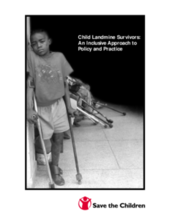There is no entirely reliable data available on anti-personnel landmines, either on the extent of their use or on the injuries and deaths they have caused; however, it is estimated that landmines kill or injure 24,000 people a year, or one person every 20 minutes. It is estimated that there are 300,000 landmine survivors: for example, one in every 415 Angolans has a landmine injury.
Over the last four decades landmines have been laid, randomly but in vast numbers, to terrorize local communities. Most affected have been countries and regions that are predominantly poor and where the political situation is unstable. With 60 to 70 million landmines lying unexploded in the ground and an estimated 250 million stockpiled by more than a hundred nations, the devastation will continue unless there is the political will and the long-term funding to change the situation.
The international community is now addressing the tasks of:
-
clearing existing mines quickly to protect communities;
-
minimizing the impact on people’s daily lives;
-
supporting landmine survivors; and
-
campaigning to stop new mines being manufactured or laid.
This report, written primarily for a non-specialist audience of donors and policy makers, offers guidance on the principles and approaches of work with children and adolescents who survive landmine injuries. Examples are given of programs that put these principles into practice. The need for community-based approaches that build on existing good practice in community-based rehabilitation (CBR) and inclusive education is stressed throughout. The report also explains why programs to promote the rights and well-being of children affected by landmine injuries must also address the wider problems of discrimination, negative attitudes and poor access to services that afflict all people with disabilities.
Investing in the reintegration of survivors is essential if children and their families are to remain productive members of society. The report discusses the types of response — ranging from changes of attitude to specific actions — required from the children, their families and communities if full integration is to be achieved. The first part of the report looks at international legislation affecting child landmine survivors. This is followed by an overview of the key issues that arise when working towards the social reintegration of child landmine survivors. The final section gives recommendations and key elements for further research.
The report has two appendices. The first is a list of organizations involved in landmine survivor assistance; the second is a bibliography of material addressing the psychological, social and economic needs of child landmine survivors.
©International Save the Children Alliance

